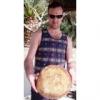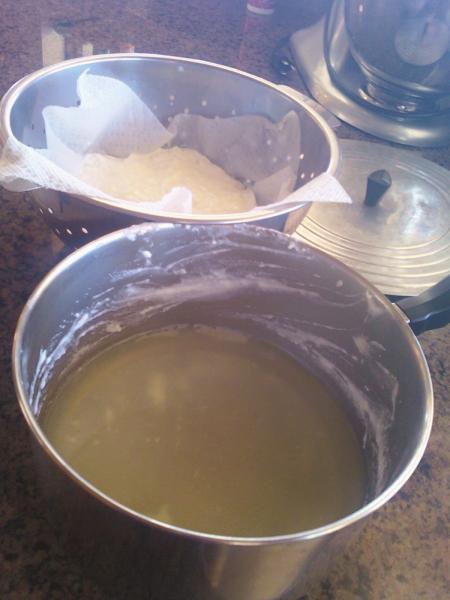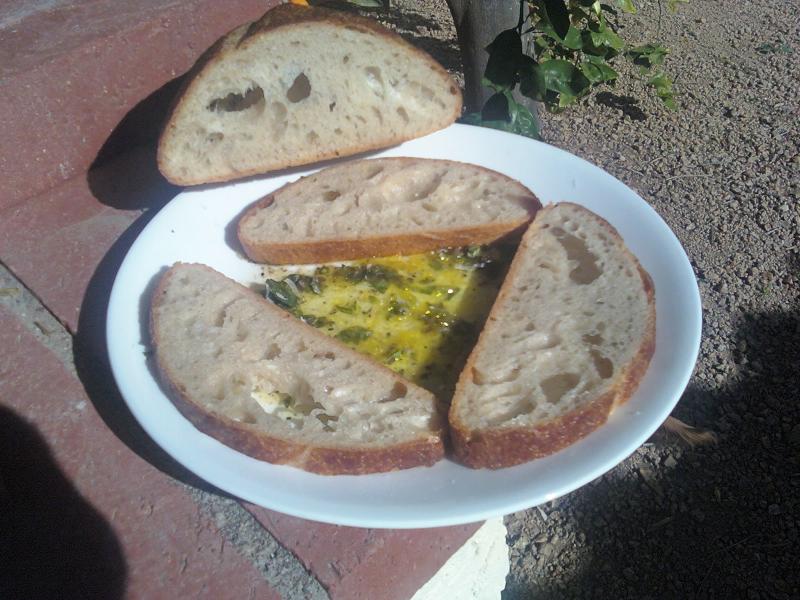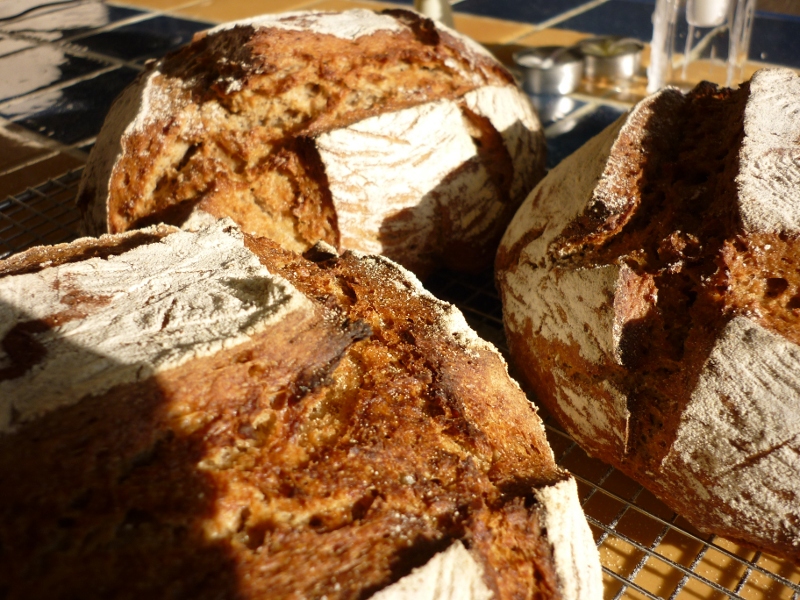
Toasted Suflower Seed Wholemeal Bread and Some Breakfast Pastries
Croissant Dough with a Sponge
My base recipe for laminated yeasted dough, with a couple of amendments. A bit of sugar is included, although my own preference remains a croissant without sugar. And I have adapted the formula to use a sponge where 20% of the total flour becomes pre-fermented.
Material | Formula [% of flour] | Recipe [grams] |
1. Sponge |
|
|
Marriage’s Strong Organic White Flour | 20 | 200 |
Fresh Yeast | 0.1 | 1 |
Water | 12 | 120 |
TOTAL | 32.1 | 321 |
|
|
|
2. Final Dough |
|
|
Sponge [from 1 above] | 32.1 | 321 |
Marriage’s Strong Organic White Flour | 80 | 800 |
Salt | 1.3 | 13 |
Sugar | 5 | 50 |
Milk Powder | 5 | 50 |
Fresh Yeast | 4 | 40 |
Water | 51 | 510 |
TOTAL | 178.4 | 1784 |
|
|
|
3. Laminating Process |
|
|
Final Dough above | 178.4 | 1784 |
Butter – lightly salted | 36 | 360 |
TOTAL | 214.4 | 2144 |
|
|
|
% pre-fermented flour | 20 | - |
% overall hydration | 63 | - |
FACTOR | 1 0 | - |
Method:
- Make the sponge the night before and leave to ferment slowly.
- For the dough, blend the milk powder, salt and sugar through the flour. Weigh very cold [I pre-chill the water overnight] water into the mixing bowl, and dissolve the fresh yeast into this. Add the sponge and the dry ingredients. Mix with a hook attachment for 3 minutes on slow and 4 minutes on second speed, scraping down the bowl as necessary.
- Cover the dough and store in the chiller for half an hour, and meanwhile cut the butter into slices and roll between 2 plastic bags to create a pliable sheet of butter.
- Roll out the croissant dough so that the slab of butter fits onto two thirds of the dough slab. Fold the butter in letter-style to create 2 layers of butter. Rest for one hour in the chiller.
- Turn through 90° and roll out to the same size as before. Fold the dough in 3 for the first turn, then chill a further hour. Repeat this 3 more times to give 4 x ½ turns in total. Rest a further one hour
- I then split the dough into 3 sections, and made 12 Pain Amande with one piece, 9 Pain aux Raisins with another, and 14 croissants with the last piece.
- Glaze each finished unit with egg, dip the Pain Amande in flaked almonds and set to proof for 45 minutes.
- I used the electric oven to bake these on convection heat setting at 210°C for approx 15 minutes each tray; there were 5 trays in total.
- Cool on wires
Yeasted Sunflower Seed Wholemeal Bread with Mixed Pre-ferments
Both cultures given 2 refreshments prior to use:
Rye Sourdough
Day | Stock | Flour | Water | Total |
Friday 09:00 | 40 | 120 | 200 | 360 |
Friday 17:00 | 360 | 60 | 100 | 520 |
Wheat Levain
Day | Stock | Flour | Water | Total |
Friday 09:00 | 40 | 200 | 120 | 360 |
Friday 17:00 | 360 | 100 | 60 | 520 |
nb. The levain was allowed to ferment slowly overnight in the chiller after the last refreshment.
Material/Stage | Formula [% of flour] | Recipe [grams] |
1a] Rye Sourdough |
|
|
Bacheldre Organic Dark Rye Flour | 9 | 180 |
Water | 15 | 300 |
TOTAL | 24 | 480 |
|
|
|
1b] Wheat Levain |
|
|
Marriage’s Organic Strong White Flour | 15 | 300 |
Water | 9 | 180 |
TOTAL | 24 | 480 |
|
|
|
2. Final Dough |
|
|
Rye Sourdough [from 1a] | 24 | 480 |
Wheat Levain [from 1b] | 24 | 480 |
Marriage’s Organic Strong Wholemeal | 76 | 1520 |
Shoyu-Roasted Sunflower Seeds | 20 | 400 |
Salt | 1.5 | 30 |
Fresh Yeast | 2.5 | 50 |
Water | 50 | 1000 |
TOTAL | 198 | 3960 |
|
|
|
% pre-fermented flour | 24 | - |
% overall hydration | 74.4 | - |
% wholegrain | 85 | - |
FACTOR | 20 | - |
Method:
- Combine wholemeal, water and rye sourdough and mix until clear with a dough hook on first speed. Autolyse for one hour.
- Add the wheat levain and bakers’ yeast and mix for 2 minutes on first speed and 3 minutes on second speed. Add the salt, mix 3 more minutes on second speed. Add the toasted seeds and mix on first speed until clear. DDT 27°C.
- Bulk ferment dough at 26°C for 2 hours.
- Knock back the dough gently, and scale and divide. I made one small panned loaf @ 500g; a large panned loaf, 3-pieced each one @ 350g; a Pullman Pan, 4-pieced each one also @ 350g. The remaining dough, just over 1kg, was used to make one large Boule. Mould each piece round, and rest covered for 15 minutes. Shape each piece and dip in seeds and assemble panned loaves, and use a banneton for the boule.
- Final proof: Boule fermented @ 26°C for one hour; 2 panned loaves followed on, so 1¾ hours proof. The Pullman was held back by fermenting at 15°C for 2½ hours.
- Bake the loaves with steam…I used my electric oven for today’s bake, pre-heated to 280°C, then settling at 235°C for 10 minutes. Then I switched to convection and baked out the breads at 210°C.
- Cool on wires
We are about to go out for dinner at our friends' home nearby. The bread is for them, as really valued customers; the pastries pictured are a gift.
All good wishes
Andy





















